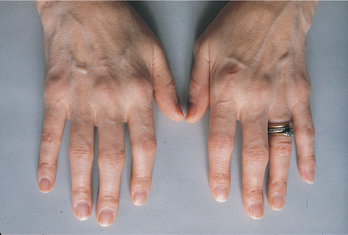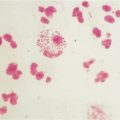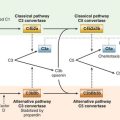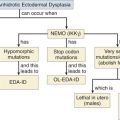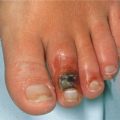CASE 23
Jurgat is a 45-year-old woman of Indian descent with severe erosive deforming rheumatoid arthritis (RA) that began at the age of 22. She has had ongoing joint problems and more recently has experienced early signs of renal failure and some chest discomfort. She has tried without benefit all conventional anti-inflammatory therapies, including NSAIDs and chronic prednisone therapy (which left her with severe osteoporosis), as well as methotrexate and even cyclosporine. She became a good candidate for more experimental approaches but she has already experienced failure in a trial using antibody to human intercellular adhesion molecule (ICAM). What was the rationale for use of this agent? What is the potential pathophysiology behind her disease manifestations?
QUESTIONS FOR GROUP DISCUSSION
RECOMMENDED APPROACH
Implications/Analysis of Clinical History
The course of RA varies from patient to patient. In Jurgat’s case, disease progression has been very aggressive. The ineffectiveness of therapies to control the inflammatory processes reflects the fact that the underlying cause of RA remains unknown.
THERAPY
Antibodies to Block Cells from Entering Synovial Tissues
TNFα and IL-1 alter both the expression (upregulate) and affinity (increase) of the integrins on leukocytes and upregulate their counter molecules on the activated endothelium (see question #1 and Case 8). Transmigration of cells into tissues requires the homo-interaction of PECAM-1, which is constitutively expressed on both leukocytes and endothelium. Activated endothelium and leukocytes also secrete enzymes (metalloproteinases) that degrade the basement membrane and permit diapedesis into the tissue.
TNFα Neutralizing Agents
There is a major proviso worthy of note for patients using TNF-neutralizing reagents. TNFα is important in signaling intracellular destruction of chronic pathogens (e.g., Mycobacterium species). Patients receiving this therapy have often had a recrudescence of tuberculosis. It would be wise to question this patient about any past history of tuberculosis and, if positive, to monitor her closely while she receives this therapy.
ETIOLOGY: RHEUMATOID ARTHRITIS
Immune Complexes in RA
Note that some of Jurgat’s complaints may represent inflammation caused by immune complex deposition. Thus, often patients with RA have circulating rheumatoid factor in their serum, an antibody to serum immunoglobulin itself. This, in turn, can lead to immune complex deposition in various tissues (serosal lining of lungs and heart) and joints with subsequent inflammation (Fig. 23-1). Both T and B cells sensitized to autoantigens (likely collagen of the connective tissue) can also stimulate inflammatory responses.

